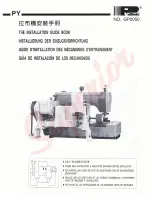
2.04 90° Corner - Right-hand male cut
Place the worktop face down. Turn the jig logo side down and place 4 pegs in the holes marked
RM
+LM and offer firmly up against the post-form edge
fig. 5
. Using the measurements
calculated in the above section, mark line C on the worktop in pencil and align the bottom edge of
the jig with this position. Clamp in position and check again to ensure all pegs are in contact with
the post-form edge and the jig is in position.
Position the router in extreme top left-hand
point of the centre slot. Set the cutting depth
to 10-15mm and start the router. Pass the
router steadily along the centre slot using the
side of the slot
nearest
you to guide the router.
Repeat this process increasing the depth of
cut by 10-15mm for each pass until the waste
has been removed. With the cutter set to
maximum depth but this time using the side of
the slot
furthest
from you to guide the router,
make one final pass which will remove
approximately 1mm, leaving a perfectly cut
edge.
RIGHT HAND MALE
Line C in pencil
Line C in pencil
Postformed Edge
Fig. 5
2.05 90° Corner - Left-hand male cut
LEFT HAND MALE
POST FORMED EDGE
Line C in Pencil
Line C in Pencil
Place the worktop
face up
and follow the instructions in 2.04.
5




























